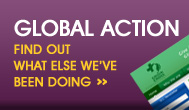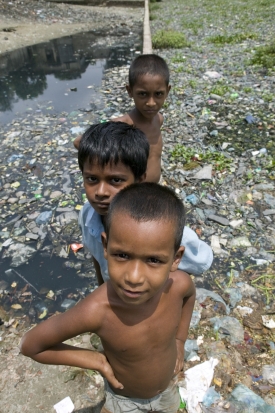

Blacksmith Institute & Green Cross Switzerland: The top six toxic threats worldwide in 2010
Green Cross Switzerland and US-based Blacksmith Institute, two independent environmental organizations, present their first ranking of the world's top six toxic threats. The ranking is included in the 2010 Toxic Threat Report, which was jointly issued by Green Cross Switzerland and Blacksmith Institute.
"The health of roughly 100 million people is at risk from pollution in developing countries," says Richard Fuller, founder of Blacksmith Institute. "The six pollutants in this report came up again and again at the sites we looked at around the world." These toxic substances cause serious health risks for up to one hundred million people around the world, especially children. The global health impacts of toxic pollutants such as heavy metals, pesticides and radionuclides are much more substantial than previously estimated. "Today more than one hundred million people are exposed to toxic concentrations that are significantly higher than international health standards," Nathalie Gysi, General Manager at Green Cross Switzerland, points out.
According to the report, the world community has taken significant steps to fight some of the most serious health threats, including Malaria and HIV/AIDS. While these pandemics have drawn a lot of attention, the connection between human health and environmental pollution has remained largely unnoticed. Despite the significant threats and the proven effectiveness of measures, only a fraction of international aid is provided for the clean-ups, the authors of the 2010 Toxic Threat Report argue.
The world's top six toxic threats 2010
The 2010 environmental report is based on over 1000 risk assessments at 600 polluted sites in more than 40 countries, which have been recorded in Blacksmith's database with support of Green Cross Switzerland.
More than 150 experts have been contracted and trained to carry out the assessment work so far. The top six toxic threats worldwide in 2010 are (in the order of the population affected):
1. Lead (18 to 22 million people affected worldwide)
2. Mercury (15 to 19 million people affected worldwide)
3. Chromium (13 to 17 million people affected worldwide)
4. Arsenic (5 to 9 million people affected worldwide)
5. Pesticides (5 to 8 million people affected worldwide)
6. Radionuclides (5 to 8 million people affected worldwide)
This year's toxic threat report ranks the pollutants according to the number of people estimated to be at risk from each toxin. It describes their physical nature and the industries that typically cause the release of the toxic substances. The report provides examples from around the world on how human health can be affected by each pollutant. A copy of the 2010 Toxic Threat Report will be available for download at www.greencross.ch on 3 November 2010, 9:00 a.m. CET.
The focus on specific pollutants reflects a more sophisticated understanding of the scope of toxic pollution globally. The 2010 report provides impressive evidence of the scope of pollution and the global distribution of each pollutant, as these toxic substances originate from a number of different sources. Lead, the world's worst toxic threat, comes from leaded gasoline for transportation, metal smelters, battery recycling, sinker production for fishing, color and ceramics manufacturing and lead mats for radiation protection. Due to its many different sources, lead is a health risk for people on every continent.
"These pollution problems can be dealt with affordably and effectively," says Dr. Stephan Robinson, Unit Manager (Water, Legacy), Green Cross Switzerland. "In many cases solutions already exist that have shown success elsewhere," adds Robinson. Past clean-up projects designed by the groups range from the very low-tech to more technical engineering projects involving soil removal at playgrounds and groundwater remediation.
The health impacts from the top six toxic threats include physical and mental disabilities, organ dysfunction, neurological disorders, cancer and in some cases death. The report also asserts that these pollutants exacerbate other health concerns by weakening the body's immune system, rendering it more susceptible to disease. According to the authors of the report, an initial exposure to toxic pollution can be the undocumented cause of later illnesses, such as respiratory infections, tuberculosis, gastrointestinal disorders, and maternal health problems.
Toxic threat criteria 2010
The 2010 ranking is based on criteria established by a group of international environmental and health experts, including researchers from Johns Hopkins University, the Bloomberg School of Public Health, Mt. Sinai Medical Center, Emory University and City University of New York. These experts are members of Blacksmith Institute's Technical Advisory Board. Specialists from Green Cross Switzerland also contributed to the report. The three main criteria include: pollutant toxicity, directness of the contamination pathway and number of affected people worldwide.
Blacksmith Institute and Green Cross Switzerland have been partners since 2006. The two organizations jointly work on projects to eliminate pollution from former mining and smelting operations in Rudnaya Pristan in far-east Russia as well as to clean up the Marilao, Meycauayan and Obando river system in the Philippines, which is heavily contaminated with industrial chemicals and household waste.
About Blacksmith Institute and Green Cross Switzerland
Blacksmith Institute is an international non-profit organization dedicated to solving life-threatening pollution issues in the developing world. It addresses a critical need to identify and clean up the world's worst polluted places. Blacksmith focuses on places where human health, especially that of women and children, is most at risk. Based in New York, Blacksmith works cooperatively in partnerships that include governments, the international community, NGOs and local agencies to design and implement innovative, low-cost solutions to save lives. Since 1999, Blacksmith has completed more than 50 projects. Blacksmith is currently engaged in around 40 projects in 20 countries.
Green Cross Switzerland facilitates overcoming consequential damages caused by industrial and military disasters and the clean-up of contaminated sites from the period of the Cold War. Central issues are the improvement of the living quality of people affected by chemical, radioactive and other types of contamination, as well as the promotion of a sustainable development in the spirit of cooperation instead of confrontation. This includes the involvement of all stakeholder groups affected by a problem. Green Cross International with headquarters in Geneva, Switzerland, was founded by the former President of the Soviet Union, Mikhail Gorbachev, in 1993. The organization is composed of a global network of 31 affiliate organizations working to support peace and security as well as to solve problems of poverty and the environment.
For additional information, please contact Dr. Stephan Robinson, Unit Manager (Water, Legacy), Green Cross Switzerland, Mobile +41 079 625 64 67.
Copyright © Green Cross Australia | Terms & Conditions | Privacy Policy
web design brisbane :: (zero)seven


